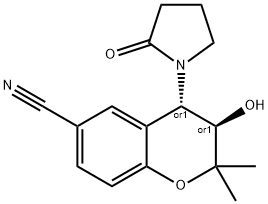Description
(±)-
Cromakalim is a prototypical activator of the ATP-
sensitive potassium channel, SUR2-
K
ir6, that displays anti-
ischemic (EC
25 = 8.9 μM) and cardioprotective (IC
50 = 0.03 μM) effects in rat hearts. (±)-
Cromakalim has also been shown to relax bladder smooth muscle
in vitro. It has been used to investigate potassium channel biology and as a scaffold to develop increasingly selective K
+ channel openers with clinical relevance.
Chemical Properties
White Crystalline Solid
Uses
Cromakalim has been used:
- as a potassium channel agonist to study its response to an acute increase in downstream pressure in rat lymphatic vessels.
- as a potassium channel opener to study its effects on the release of transmitters from adrenergic nerves in rat vas deferens.
- as a potassium channel activator to study its effects on the release of transmitters from purinergic and cholinergic nerves in the rat detrusor muscle.
Uses
Cromakalim causes vasodilation by activation of potassim channels
Definition
ChEBI: Cromakalim is a 1-benzopyran.
Biological Activity
Prototypical K ATP channel opener. Relaxes rabbit isolated portal vein with an IC 50 value of 21 nM . Potent, orally active and hypotensive in vivo .
Biochem/physiol Actions
Cromakalim is an activator of the potassium channel. It is involved in the relaxation of the vascular smooth muscles. Cromakalim exhibits anti-hypertensive activity.
References
1) Sanguinetti?et al. (1988),?BRL 34915 (cromakalim) activates ATP-sensitive K+ current in cardiac muscle; Proc. Natl. Acad. Sci. USA,?85?8360
2) Wu?et al.?(2011),?Reopening of ATP-sensitive potassium channels reduces neuropathic pain and regulates astroglial gap junctions in the rat spinal cord; Pain,?152?2605
3) Roy Chowdhury?et al.?(2017),?ATP sensitive potassium channel openers: A new class of ocular hypotensive agents; Exp. Eye Res.,?158?85
4) Cao?et al.?(2016),?Opening of the Adenosine Triphosphate-sensitive Potassium Channel Attenuates Morphine Tolerance by Inhibiting JNK and Astrocyte Activation in the Spinal Cord; Clin. J. Pain,?32?617
